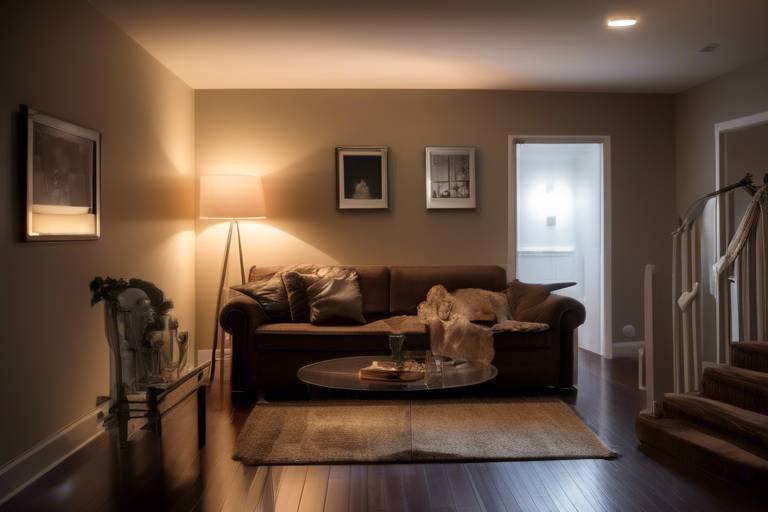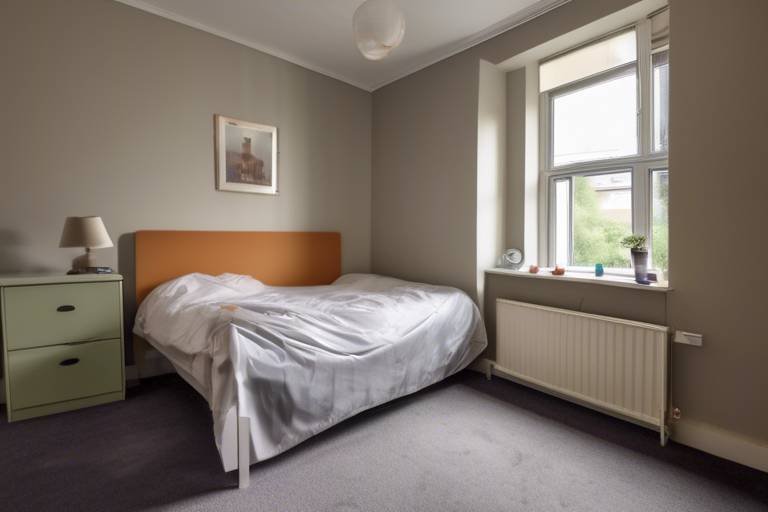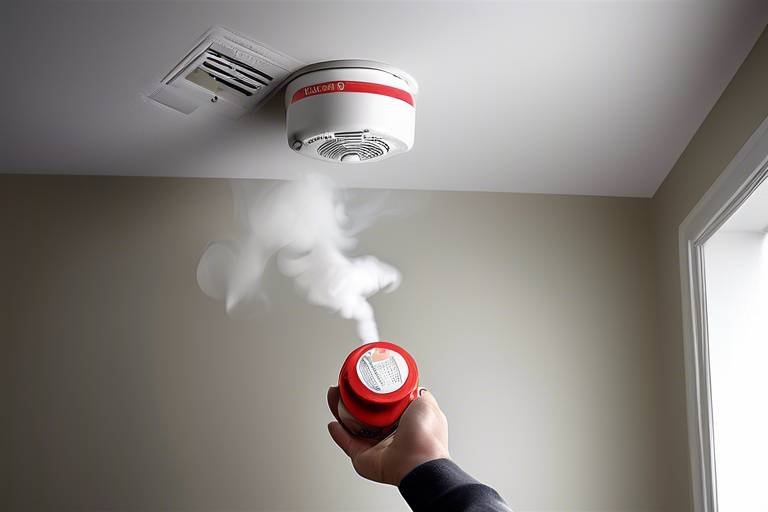Detecting Home Intruders – Alarm Systems Explained
In an age where home safety is paramount, understanding the intricacies of alarm systems can make all the difference in protecting your sanctuary. Alarm systems are not just a luxury; they are a necessity for homeowners who want to shield their families and belongings from potential threats. Whether you live in a bustling city or a quiet suburb, the peace of mind that comes with a reliable alarm system is invaluable. This article will guide you through the various types of alarm systems available today, breaking down their features, functionalities, and the benefits they offer in detecting and deterring intruders effectively.
When it comes to securing your home, not all alarm systems are created equal. There are several types to choose from, each tailored to meet specific security needs and preferences. The three primary categories include:
- Wired Alarm Systems: These systems are hardwired into your home’s electrical system, making them reliable but often more difficult to install and modify.
- Wireless Alarm Systems: These use radio signals to communicate between components, offering flexibility and ease of installation without the need for extensive wiring.
- Smart Alarm Systems: Integrated with smart home technology, these systems can be controlled via smartphone apps, providing real-time alerts and remote monitoring capabilities.
Each type has its unique advantages and disadvantages. For instance, while wired systems may offer more stability, wireless options provide greater convenience and ease of installation. Ultimately, the choice depends on your specific needs and lifestyle.
To fully appreciate how alarm systems function, it’s essential to understand their key components. These include sensors, control panels, and alarms, each playing a critical role in the overall effectiveness of the system. Let’s break them down:
Motion sensors are the frontline defenders in your security arsenal. They are designed to detect movement in and around your home, triggering alerts when unexpected activity occurs. The technology behind them varies, with the most common types being passive infrared and microwave sensors. Each type offers different levels of sensitivity and coverage, making it crucial to choose the right one for your environment.
Passive infrared sensors are widely used for indoor security. They detect body heat, which allows them to identify human presence effectively. Their reliability and low false alarm rates make them a popular choice for residential alarm systems. Imagine walking into a room and having the lights turn on automatically—this is similar to how passive infrared sensors work, responding only to significant heat changes.
On the other hand, microwave sensors emit microwave signals to detect movement. They can cover larger areas than passive infrared sensors, making them suitable for both indoor and outdoor applications. Think of them as a radar system that sweeps the area, ensuring no intruder goes unnoticed. However, they may be more prone to false alarms due to interference from pets or moving objects.
The control panel is the brain of your alarm system. It allows you to arm and disarm the system, manage settings, and receive alerts. Understanding its features is vital for selecting a system that meets your security needs. Modern control panels often come with touchscreen interfaces, making them user-friendly and intuitive. Some even offer smartphone integration, allowing you to monitor your home from anywhere in the world.
Once your alarm system is in place, how it is monitored can significantly affect your security. There are several monitoring options available:
- Self-Monitoring: This option allows homeowners to receive alerts directly to their devices. While it can be cost-effective, it requires users to respond quickly to potential threats, which may not always be feasible.
- Professional Monitoring: This involves a dedicated security service that monitors alarms 24/7. Trained professionals can respond promptly to alerts and dispatch authorities if necessary, providing peace of mind.
- Remote Monitoring: Through mobile apps, homeowners can monitor their systems in real-time, receiving instant notifications and updates, making it easier to manage security on the go.
Self-monitoring can be appealing due to its lower costs, but it comes with the responsibility of immediate action. Imagine receiving an alert while you’re out grocery shopping—do you rush home or call a neighbor? This option requires a proactive approach, which might not always be practical.
On the flip side, professional monitoring offers a layer of security that self-monitoring simply can’t match. With trained professionals on the lookout 24/7, you can rest easy knowing that someone is always ready to respond to alerts and take necessary actions. This peace of mind is often worth the investment for many homeowners.
As you consider your options for home security, you may have some questions. Here are a few common inquiries regarding alarm systems:
- How much do alarm systems cost? The cost can vary significantly based on the type of system, components, and monitoring options. Basic systems can start as low as a few hundred dollars, while advanced smart systems may cost thousands.
- Can I install an alarm system myself? Yes, many wireless and smart systems are designed for easy DIY installation. However, wired systems may require professional installation.
- What happens if the alarm goes off accidentally? Most systems allow you to disarm them quickly, but repeated false alarms can lead to fines from local authorities.
In conclusion, investing in a reliable alarm system is a crucial step in safeguarding your home. By understanding the types, components, and monitoring options available, you can make an informed decision that enhances your security and provides peace of mind.

Types of Alarm Systems
When it comes to securing your home, understanding the various is crucial. Each system has its own unique features, advantages, and disadvantages that cater to different security needs and preferences. The three primary types of alarm systems are wired, wireless, and smart systems. Let’s break these down to see what makes each one tick!
Wired alarm systems are the traditional choice, often seen in homes built before the rise of wireless technology. These systems are hardwired into the electrical system of your home, providing a stable and reliable connection. The key advantage of wired systems is their reliability; they are less susceptible to interference and can often handle more extensive installations. However, installation can be labor-intensive and may require professional help, which can be a downside for some homeowners.
On the flip side, we have wired systems. These systems have gained immense popularity due to their ease of installation and flexibility. Wireless alarm systems use radio signals to transmit data, which means they can be set up quickly without the need for extensive wiring. This is particularly beneficial for renters or those looking to avoid the hassle of drilling holes in walls. However, they can be vulnerable to interference from other wireless devices, and battery maintenance is essential to ensure they remain operational.
Lastly, let’s talk about smart systems. In this age of technology, smart alarm systems are becoming the go-to choice for many homeowners. These systems can be integrated with your smartphone, allowing you to monitor your home from anywhere in the world. Imagine being on vacation and receiving an alert about suspicious activity in your living room! Smart systems often come equipped with features like video surveillance, remote access, and automation, giving you peace of mind like never before. However, they do require a reliable internet connection and can be more expensive than traditional systems.
To summarize, here’s a quick comparison of the three types of alarm systems:
| Type | Advantages | Disadvantages |
|---|---|---|
| Wired | Reliable, less interference | Labor-intensive installation |
| Wireless | Easy installation, flexible | Vulnerable to interference, battery maintenance |
| Smart | Remote access, advanced features | Requires internet, potentially more expensive |
Choosing the right type of alarm system ultimately depends on your specific needs and circumstances. Are you a tech-savvy individual who wants to control everything from your smartphone? Or do you prefer the reliability of a wired system? Understanding the pros and cons of each can help you make an informed decision that keeps your home safe and sound.
- What is the best type of alarm system for a small apartment? Wireless systems are often the best choice for apartments due to their easy installation and flexibility.
- How often should I test my alarm system? It's recommended to test your alarm system at least once a month to ensure everything is functioning properly.
- Can I integrate my alarm system with other smart home devices? Yes, many modern alarm systems can be integrated with various smart home devices for enhanced security and convenience.

Components of Alarm Systems
Understanding the key components of alarm systems is essential for evaluating their effectiveness in securing your home from intruders. Each part plays a crucial role in the overall functionality of the system, working together to create a comprehensive security solution. Think of these components as the gears in a well-oiled machine, where each gear must function properly to keep the system running smoothly. The primary components include sensors, control panels, alarms, and monitoring systems. Let’s break these down a bit further.
Sensors are the frontline defenders in any alarm system. They are designed to detect unauthorized entry and alert you to potential threats. Different types of sensors cater to various needs and environments:
- Motion Sensors: These sensors are crucial for detecting movement in and around your home. They can be installed indoors or outdoors and come in two main types: passive infrared (PIR) and microwave sensors.
- Door and Window Sensors: These sensors trigger an alarm when a door or window is opened. They are typically magnetic and are installed on the frame and the door or window itself.
- Glass Break Sensors: These sensors detect the specific frequency of breaking glass, providing an additional layer of security, especially for homes with large windows.
The control panel is essentially the brain of your alarm system. It allows you to arm and disarm the system and can often be customized to suit your preferences. Most modern control panels come equipped with a user-friendly interface, making it easy to manage your security settings. Some advanced systems even allow for remote access via mobile apps, giving you the ability to monitor your home from anywhere. When selecting a control panel, consider factors such as:
- Ease of use
- Compatibility with other devices
- Features like touchscreens or voice activation
Alarms are the loud, attention-grabbing alerts that notify you and your neighbors of a potential intrusion. They can be audible alarms, which emit a loud sound, or silent alarms that notify the monitoring service without alerting the intruder. The effectiveness of an alarm system often hinges on the type of alarm used. For instance, a high-decibel siren can deter intruders simply by being loud enough to attract attention. Conversely, silent alarms are useful for discreetly alerting authorities without causing panic.
Finally, monitoring systems play a vital role in ensuring that your alarm system is always on guard. They can be self-monitored, professionally monitored, or a combination of both. Self-monitoring allows homeowners to receive alerts directly on their mobile devices, but it requires them to be vigilant and responsive. On the other hand, professional monitoring offers round-the-clock surveillance by trained professionals who can act swiftly in emergencies. This option often includes features such as:
- 24/7 monitoring
- Immediate dispatch of authorities
- Regular system checks and updates
In conclusion, understanding the components of alarm systems helps homeowners make informed decisions about their security needs. Each component, from sensors to monitoring options, plays a critical role in creating a robust defense against intruders. By choosing the right combination of these elements, you can significantly enhance your home’s security and gain peace of mind.
Q1: What is the best type of alarm system for my home?
A1: The best type of alarm system depends on your specific needs. Consider factors like the size of your home, your budget, and whether you prefer a wired or wireless system. Smart systems offer advanced features but may require a higher investment.
Q2: How often should I test my alarm system?
A2: It's recommended to test your alarm system at least once a month to ensure that all components are functioning correctly. Regular maintenance checks can also help identify any issues before they become serious problems.
Q3: Can I install an alarm system myself?
A3: Many modern alarm systems are designed for easy DIY installation. However, if you're not comfortable with technology or electrical work, hiring a professional installer may be a better option.

Motion Sensors
When it comes to home security, are like the vigilant eyes that never blink. They play a crucial role in detecting movement both inside and outside your home, acting as the first line of defense against potential intruders. Imagine a silent guardian that can sense even the faintest disturbance; that’s what motion sensors do. They utilize various technologies to ensure that your home remains safe, and understanding how they work can help you choose the right system for your needs.
There are primarily two types of motion sensors that homeowners should consider: Passive Infrared Sensors (PIR) and Microwave Sensors. Each type operates on different principles and offers unique benefits and drawbacks. For instance, passive infrared sensors detect changes in heat emitted by objects, making them highly effective for indoor use. On the other hand, microwave sensors emit microwave signals to detect movement, allowing them to cover larger areas, which can be beneficial for outdoor security.
Let’s dive a little deeper into the two types:
| Type of Sensor | How It Works | Best Use |
|---|---|---|
| Passive Infrared Sensors | Detects body heat and movement | Indoor security |
| Microwave Sensors | Emits microwave signals to detect movement | Indoor and outdoor security |
Passive Infrared Sensors are particularly popular in residential settings due to their reliability and low false alarm rates. They are designed to detect only significant changes in infrared radiation, which usually means a person or animal is moving through the area. This makes them less likely to trigger false alarms from pets or passing cars. However, they do have limitations; for example, they may struggle to detect motion through thick walls or in areas with obstructed views.
On the flip side, Microwave Sensors are more versatile. By emitting microwave signals, they can cover a broader area and detect movement through walls and other obstacles. This makes them ideal for outdoor applications, such as securing your yard or driveway. However, they can be more prone to false alarms, especially if there are moving objects like trees swaying in the wind or small animals wandering around.
In conclusion, motion sensors are an essential component of any home security system. By understanding the differences between passive infrared and microwave sensors, you can make an informed decision that best suits your home’s security needs. After all, in the world of home safety, knowledge is power, and having the right tools can help protect what matters most to you.

Passive Infrared Sensors
, often abbreviated as PIR sensors, are a cornerstone of modern home security systems. Their primary function is to detect the heat emitted by living beings, making them incredibly effective for indoor security applications. Imagine a silent guardian that stands watch over your home, continuously scanning for any signs of movement. This technology is not just about detecting motion; it’s about recognizing the warmth of a body, which is why they are so reliable in minimizing false alarms.
These sensors work by measuring changes in infrared radiation within their field of view. When a warm body, such as a human or pet, crosses their path, the sensor picks up on the heat change. This triggers the alarm system to alert homeowners or monitoring services. The effectiveness of PIR sensors lies in their ability to distinguish between different heat sources, allowing them to ignore non-threatening movements, like a passing car or a small animal. This feature not only enhances security but also saves you from the annoyance of false alarms.
One of the most appealing aspects of passive infrared sensors is their cost-effectiveness. They are typically less expensive than other types of sensors, such as microwave sensors, while still delivering reliable performance. Furthermore, PIR sensors are energy-efficient, which means they can operate for extended periods without drawing much power. This is particularly beneficial for homeowners looking to maintain a budget-friendly security system.
However, like any technology, passive infrared sensors have their limitations. For instance, they are most effective in enclosed spaces or areas where there is minimal obstruction. If you’re considering installing these sensors outdoors, they may require additional housing or protective casings to shield them from environmental factors. Moreover, they can struggle with detecting motion in large open areas or when the temperature fluctuates significantly. To counter these issues, many homeowners opt to combine PIR sensors with other types of sensors, creating a multi-layered security system that offers comprehensive protection.
In terms of installation, passive infrared sensors are relatively easy to set up. Most systems come with user-friendly instructions, and many can be integrated seamlessly with existing alarm systems. Here are a few key points to consider when installing PIR sensors:
- Position them at a height of 6 to 8 feet for optimal detection.
- Avoid placing them in direct sunlight to reduce false alarms.
- Ensure they have a clear line of sight to the areas you want to monitor.
In summary, passive infrared sensors are an invaluable asset for any home security system. They combine reliability, affordability, and ease of use, making them a popular choice among homeowners. By understanding their capabilities and limitations, you can make informed decisions about how to best protect your home from intruders.
1. How do passive infrared sensors work?
PIR sensors detect changes in infrared radiation caused by moving warm bodies. When a person or animal enters their field of view, the sensor triggers the alarm system.
2. Can passive infrared sensors be used outdoors?
Yes, but they may require protective casings to shield them from weather elements and to enhance their effectiveness in outdoor settings.
3. Are passive infrared sensors prone to false alarms?
While they are designed to minimize false alarms, factors like pets, moving trees, or temperature fluctuations can sometimes trigger them. Proper placement can help reduce these occurrences.
4. How can I enhance the effectiveness of PIR sensors?
Combining PIR sensors with other types of sensors, such as door/window contacts or microwave sensors, can create a more robust security system.

Microwave Sensors
When it comes to enhancing your home security, are a game changer. These devices work by emitting microwave signals that bounce off objects in their path. If there's any movement—like a person walking through the area—the sensor detects the change in the reflected signals and triggers the alarm. This technology not only offers a high level of sensitivity but also provides a broader coverage area compared to other types of sensors, making them particularly effective for both indoor and outdoor applications.
One of the most appealing features of microwave sensors is their ability to cover large spaces. For instance, they can easily monitor expansive backyards or wide-open living areas without the need for multiple devices. This can be a huge advantage for homeowners who want to keep an eye on their property without cluttering it with numerous sensors. However, it's important to note that their wide coverage can sometimes lead to false alarms, especially in environments with pets or frequent movement.
Additionally, microwave sensors can be used in conjunction with other security devices, creating a layered approach to home protection. For example, pairing them with passive infrared sensors can significantly reduce the chances of false alarms while ensuring comprehensive coverage. This dual-technology approach allows homeowners to benefit from the strengths of both sensor types, maximizing their security system's effectiveness.
In terms of installation, microwave sensors are generally straightforward to set up. They can be mounted on walls or ceilings, depending on the layout of your home and the areas you wish to monitor. Many modern systems even offer wireless options, allowing for easy installation without the hassle of running wires through your walls. This flexibility not only makes them user-friendly but also allows homeowners to adapt their security systems as their needs change.
In conclusion, microwave sensors are a powerful tool in the arsenal of home security. Their ability to detect movement over a wide area, combined with their compatibility with other security technologies, makes them an excellent choice for anyone looking to bolster their home’s defenses. Whether you're protecting your home from intruders or simply keeping an eye on your property, incorporating microwave sensors into your security system can provide an added layer of safety and peace of mind.
- What is the main advantage of microwave sensors over other types of sensors?
Microwave sensors can cover larger areas and are less prone to obstructions, making them ideal for both indoor and outdoor use. - Can microwave sensors be used outdoors?
Yes, they are designed to work effectively outdoors, but proper placement is crucial to minimize false alarms. - Do microwave sensors work well with pets in the house?
They can be sensitive to movement, so it's important to choose models that can differentiate between pets and humans to reduce false alarms.

Control Panels
The control panel is often referred to as the "brain" of your home alarm system, and for good reason! It’s the central hub that allows you to manage and monitor your security setup. Think of it as the command center of a spaceship, where all the vital information comes together to keep you safe. When you arm or disarm your system, it’s the control panel that processes your commands and activates the necessary sensors. A good control panel will not only be user-friendly but also feature-rich, allowing you to customize settings according to your specific security needs.
Control panels come in various forms, ranging from simple keypad interfaces to advanced touch-screen models. Some even integrate with your smartphone, enabling you to control your home security remotely. Imagine being on vacation and being able to check the status of your home with just a few taps on your phone! This level of convenience is what modern technology brings to the table.
When choosing a control panel, consider the following features:
- Ease of Use: Look for intuitive designs that make it easy to navigate through settings.
- Remote Access: Ensure the panel allows for mobile app integration so you can monitor your home from anywhere.
- Customization: The ability to customize alerts and settings can significantly enhance your security experience.
- Integration: If you have smart home devices, opt for a control panel that can seamlessly integrate with them.
Additionally, many modern control panels offer features like voice commands and facial recognition, which can add an extra layer of convenience and security. Imagine walking up to your home, and as you approach, the system recognizes you and disarms itself automatically! This kind of technology not only feels futuristic but also simplifies your daily routine.
In conclusion, the control panel is a crucial element of your home security system. It’s not just a tool for arming and disarming your alarms; it’s a gateway to a more secure and manageable home. By understanding its features and capabilities, you can make an informed decision that best meets your security needs. So, whether you prefer the simplicity of a keypad or the sophistication of a smart panel, remember that the right control panel can make all the difference in keeping your home safe from intruders.
Here are some common questions homeowners have about control panels and alarm systems:
- What happens if the power goes out? Most control panels have a battery backup that keeps them operational during power outages.
- Can I install a control panel myself? While some systems are designed for DIY installation, it’s often best to consult a professional for optimal setup.
- Are control panels compatible with all alarm systems? Not necessarily; always check compatibility before purchasing a new control panel.

Monitoring Options
When it comes to securing your home, the available for alarm systems play a crucial role in how effectively you can protect your property. Imagine this: you’re on vacation, sipping a cocktail on a sunny beach, and suddenly you receive an alert on your phone about suspicious movement detected at your home. Wouldn’t it be comforting to know you have a reliable monitoring system in place? There are several ways to monitor your alarm system, each with its own set of pros and cons. Let's break it down!
First up is self-monitoring. This option allows homeowners to take control of their security by receiving alerts directly to their smartphones or devices. It’s like having a security guard in your pocket! However, while self-monitoring can save you some bucks, it does come with a hefty responsibility. You need to be vigilant and ready to respond quickly to any alerts, which might not always be practical. After all, who wants to be glued to their phone when they could be enjoying life? Self-monitoring works best for those who are tech-savvy and can react swiftly to potential threats.
Then we have professional monitoring. This is where things get a bit more serious. With professional monitoring, a dedicated security service watches over your home 24/7. Think of it as having a team of experts keeping an eye on your property while you go about your daily life or travel the world. If an alarm goes off, the monitoring center is alerted immediately and can take action, whether that means contacting the authorities or notifying you. This option provides peace of mind, especially for those who might not be able to respond quickly to alerts themselves.
Lastly, there’s remote monitoring through mobile apps. This modern marvel allows you to check on your home security from anywhere, anytime. You can view live camera feeds, receive alerts, and even control your alarm system right from your smartphone. It’s like having a virtual security system at your fingertips! Remote monitoring combines the best of both worlds, giving you the flexibility of self-monitoring with the reassurance of professional oversight. You can enjoy your vacation knowing you have the ability to check in on your home whenever you want.
To sum it all up, the choice of monitoring option depends on your personal preferences, lifestyle, and budget. Here’s a quick comparison to help you decide:
| Monitoring Option | Pros | Cons |
|---|---|---|
| Self-Monitoring | Cost-effective, immediate alerts | Requires quick response, may miss threats |
| Professional Monitoring | 24/7 oversight, quick response from authorities | Higher cost, reliance on third-party service |
| Remote Monitoring | Flexibility, real-time access | Requires internet connectivity, can be complex |
Choosing the right monitoring option can make all the difference in how secure you feel in your home. Whether you prefer the hands-on approach of self-monitoring or the comprehensive coverage of professional services, understanding your needs and options is key to effective home security.
As we wrap up this discussion on monitoring options, you might have some questions swirling in your mind. Here are a few frequently asked questions that can help clarify any doubts:
- What is the best monitoring option for a small apartment? Self-monitoring might be sufficient if you live in a small space and can quickly respond to alerts.
- How much does professional monitoring typically cost? Prices can vary widely, but you can expect to pay anywhere from $15 to $50 per month.
- Can I switch between monitoring options? Yes, many alarm systems allow you to change your monitoring preference, so you can adapt as your needs change.

Self-Monitoring
Self-monitoring is an increasingly popular option for homeowners who want to keep a close eye on their property without incurring the costs associated with professional monitoring services. Imagine having the power to check on your home from anywhere, anytime, right from your smartphone! This method puts you in the driver’s seat, allowing you to receive alerts directly to your devices, such as your mobile phone or tablet, whenever something unusual is detected. However, while self-monitoring can be incredibly convenient and cost-effective, it does come with its own set of challenges and responsibilities.
One of the main advantages of self-monitoring is the **immediate access** it offers. You can receive notifications about potential intrusions, environmental hazards like smoke or carbon monoxide, and even system malfunctions. This means you can take action quickly, whether that’s checking your security cameras or calling the authorities. However, the effectiveness of this approach largely depends on your ability to respond promptly. If you’re at work, on vacation, or simply away from your phone, you might miss crucial alerts, which could lead to dire consequences.
Self-monitoring systems often come equipped with various features to enhance your security experience. These may include:
- Real-time notifications: Get instant alerts about any suspicious activity.
- Remote access: Control your alarm system from anywhere using a mobile app.
- Video surveillance: Monitor live feeds from security cameras set up around your home.
While self-monitoring can save you money, it’s essential to weigh these benefits against the potential risks. For instance, if you’re not able to respond quickly to an alert, the system may be rendered less effective. Additionally, self-monitoring does not typically include the **professional support** that comes with a monitored system, which can be crucial during emergencies. This can lead to a feeling of vulnerability, especially if you live in an area with a higher rate of crime.
Ultimately, the decision to go with self-monitoring should be based on your lifestyle, comfort level with technology, and the specific security needs of your home. If you’re tech-savvy and can commit to staying alert, self-monitoring might be the perfect fit. However, if you prefer peace of mind knowing that trained professionals are watching over your home, you might want to consider professional monitoring instead.
Here are some common queries homeowners have about self-monitoring systems:
- How does self-monitoring work? Self-monitoring systems send alerts directly to your devices when a sensor is triggered, allowing you to take immediate action.
- Is self-monitoring safe? While it can be safe, it requires you to be responsive to alerts. If you’re unable to act quickly, your home may be at risk.
- What features should I look for in a self-monitoring system? Look for real-time notifications, remote access via a mobile app, and video surveillance capabilities.

Professional Monitoring
When it comes to home security, stands out as one of the most reliable options available. Imagine having a dedicated team of experts watching over your home, ready to spring into action at a moment's notice. This level of vigilance can provide you with unparalleled peace of mind, knowing that trained professionals are monitoring your alarm system 24/7. But what exactly does professional monitoring entail, and why should you consider it for your home?
In a nutshell, professional monitoring means that your alarm system is connected to a monitoring center, where operators keep an eye on alerts. If your alarm goes off, the monitoring center is immediately notified and can take swift action. This could involve contacting you to verify the alarm or directly dispatching local authorities if necessary. The speed of this response can be crucial in preventing theft or damage, making it a smart choice for homeowners who value security.
One of the key benefits of professional monitoring is the quick response time. While self-monitoring may alert you to a potential intruder, it relies on you to act quickly. What if you’re at work, on vacation, or simply can't get to your phone in time? Professional monitoring eliminates that uncertainty. The dedicated team is there to respond, ensuring that help is on the way, no matter where you are.
Additionally, many professional monitoring services offer extra features that can enhance your security experience. Here are a few examples:
- 24/7 Availability: No matter the time of day, your home is being monitored.
- Emergency Dispatch: Immediate contact with local law enforcement or emergency services.
- Regular System Checks: Ensures that your alarm system is functioning correctly and efficiently.
Moreover, professional monitoring can be tailored to your specific needs. Whether you live in a bustling urban area or a quiet suburb, your security requirements are unique. Many services offer customizable plans that can include additional sensors, surveillance cameras, or even smart home integrations, allowing you to create a comprehensive security solution that fits your lifestyle.
Of course, there are costs associated with professional monitoring. Typically, you can expect to pay a monthly fee, which can vary depending on the level of service and features you choose. However, consider it an investment in your safety and peace of mind. The cost of replacing stolen items or repairing damage can far exceed the expense of a monitoring service.
In conclusion, opting for professional monitoring can significantly enhance your home security. It provides a layer of protection that self-monitoring simply cannot match. With trained professionals at the ready, you can rest easy knowing that your home is in good hands, day and night. So, if you’re serious about keeping your home safe from intruders, professional monitoring might just be the way to go.
Q: How much does professional monitoring cost?
A: The cost can vary widely based on the service provider and the features you choose, but it typically ranges from $15 to $50 per month.
Q: Can I still monitor my system if I have professional monitoring?
A: Yes! Many professional monitoring services offer mobile apps that allow you to monitor your system in real-time.
Q: What happens if there’s a false alarm?
A: Most monitoring services will contact you to verify the alarm. If it’s a false alarm, they will cancel the dispatch. However, repeated false alarms may incur fees.
Frequently Asked Questions
- What are the different types of alarm systems available?
There are primarily three types of alarm systems: wired, wireless, and smart systems. Wired systems are typically more reliable but can be costly to install. Wireless systems offer flexibility and easier installation, while smart systems integrate with your home automation, allowing you to control them via your smartphone.
- How do motion sensors work in alarm systems?
Motion sensors detect movement through various technologies. Passive infrared sensors identify body heat, making them ideal for indoor use. In contrast, microwave sensors send out microwave signals to cover larger areas, suitable for both indoor and outdoor applications.
- What is the role of a control panel in an alarm system?
The control panel acts as the brain of the alarm system. It allows you to arm and disarm the system and often features a keypad or touchscreen interface. Understanding its functionalities is crucial for selecting a system that meets your specific security needs.
- What are the monitoring options for alarm systems?
Alarm systems can be monitored in several ways: self-monitoring, professional monitoring, and remote monitoring through mobile apps. Self-monitoring sends alerts directly to your device, while professional monitoring involves a dedicated service that watches over your home 24/7.
- What are the advantages of professional monitoring?
Professional monitoring offers peace of mind as trained professionals are always on alert. They can respond quickly to alarms and contact authorities if necessary, ensuring a swift response to potential threats.
- Can I install an alarm system myself?
Yes, many wireless and smart alarm systems are designed for easy DIY installation. However, if you opt for a wired system or want a more complex setup, it may be best to hire a professional to ensure everything is installed correctly.



















